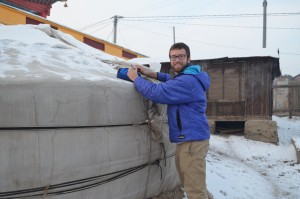18 December 2015
Policy changes in Mongolian capital could improve health, decreasing lives lost to air pollution
Posted by lhwang

The city of Ulaanbaatar, Mongolia sits in a valley where pollution is easily trapped.
Credit: Drew Hill
by Lindzi Wessel
Exposure to dangerous contaminants in Ulaanbaatar, Mongolia could increase by 10 percent or more by 2024, exacerbating health problems in one of the most polluted cities in the world, a new study finds.
Residents of Ulaanbaatar, the most populous city in Mongolia, rely heavily on coal to survive frigid winters in a valley where air pollution is easily trapped. Air pollution in Ulaanbaatar caused an estimated 1,250 premature deaths in 2014, according to Drew Hill, a graduate student in environmental health at the University of California, Berkeley. Hill was part of a research team that presented an air pollution and health report to the Mongolian Ministry of the Environment and Green Development in the summer of 2014.

Residents in Ulaanbaatar, Mongolia rely heavily on coal to get through harsh winters.
Credit: Drew Hill
The research team advised that aggressive cuts to emissions from traffic and power plants, in addition to a shift to cleaner indoor stoves and heaters, could reduce the per-capita health burden from poor air quality by up to 70 percent. They also included suggestions for less ambitious changes that would still reduce health impact by about 30 percent. Hill presented these projections at the 2015 American Geophysical Union Fall Meeting in San Francisco.
To produce a model most reflective of Ulaanbaatar lifestyles, the team investigated both outdoor exposure levels and tested for indoor contaminants in various types of housing. Residents of Ulaanbaatar invited researchers into their homes, where they used specialized equipment to suck air through filters for testing. Once they identified particles left on the filter, the researchers were able to calculate the proportion of various contaminants in each home, Hill said.
It turns out the type of housing matters, Hill said. Many Ulaanbaatar residents live in circular tent-like structures called “gers” equipped with wood or coal stoves and heaters. A large amount of exposure to toxic air contaminants occurs in gers and other homes erected by residents, according to the study. Improving in-home energy sources could have a substantial impact on health, Hill said.
Other contributors to air pollution include Ulaanbaatar’s three power plants, low traffic emission standards, and a 60 to 70 percent smoking rate, Hill added. The excessive contaminants plague the people of Ulaanbaatar with increased levels of heart disease, stroke and respiratory complications, according to the research.
Hill said he and his colleagues hope Mongolian policymakers will use their findings to improve public health. Since the analysis, the Mongolian government has already enacted stricter public smoking laws. “Mongolia continues to go down a strong path in the regulation of air pollution,” Hill said.
– Lindzi Wessel is a science communication graduate student at UC Santa Cruz. You can follow her on twitter at @LindziWessel











 GeoSpace is a blog on Earth and space science, managed by AGU’s Public Information staff. The blog features posts by AGU writers and guest contributors on all sorts of relevant science topics, but with a focus on new research and geo and space sciences-related stories that are currently in the news.
GeoSpace is a blog on Earth and space science, managed by AGU’s Public Information staff. The blog features posts by AGU writers and guest contributors on all sorts of relevant science topics, but with a focus on new research and geo and space sciences-related stories that are currently in the news.
thanks for sharing such a nice blog about UlaanBataar, I have visit lot of websites for know about this capital city of Mongolia, here my searches stopped… again thanks for sharing it, keep it up.